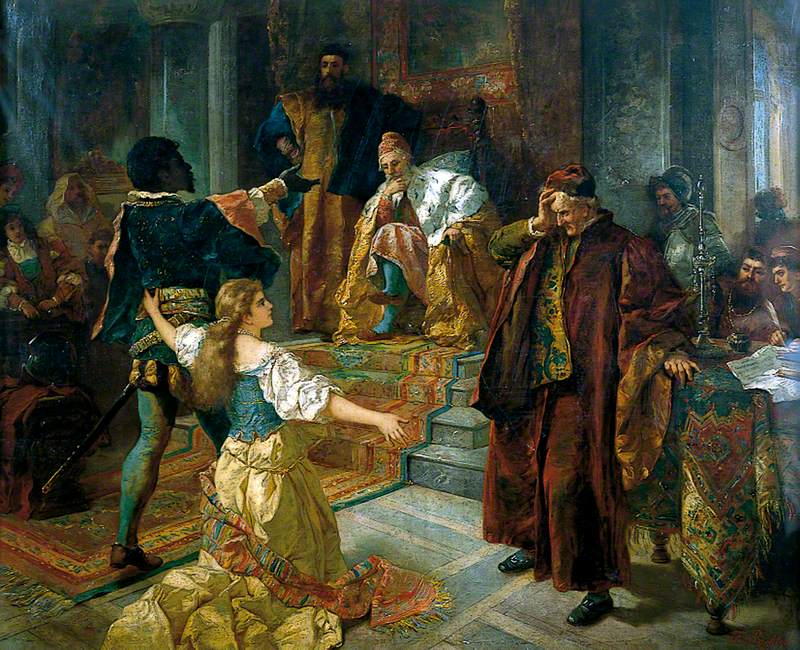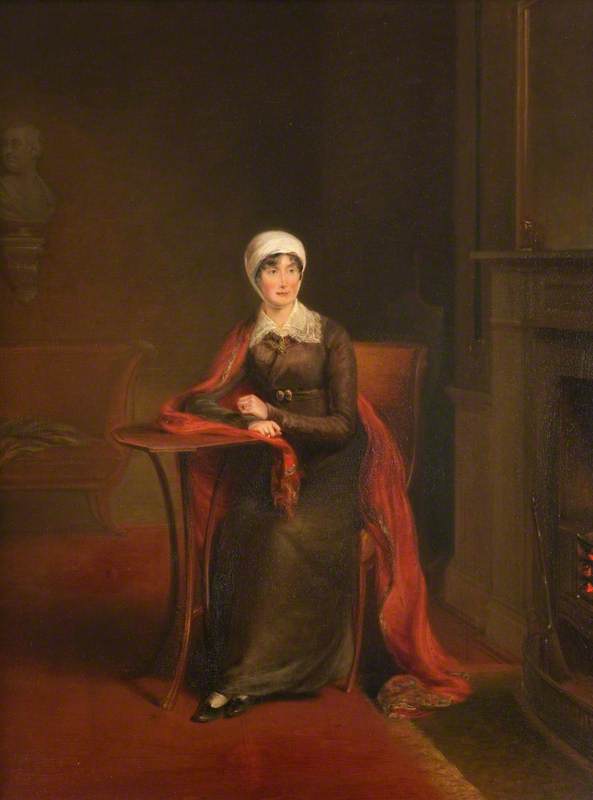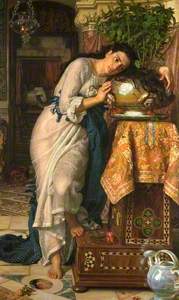It's September: leaves are changing colour, conkers are on the ground, and National Poetry Day is fast approaching. On Thursday 28th September, people up and down the country will celebrate by sharing favourite lines of verse, taking part in events or maybe putting pen to paper themselves. The BBC is shining a light on poetry with Contains Strong Language, a four-day poetry and spoken word festival.
Over the last six months, we've been looking to bring new perspectives to the nation's art. In our Art Speaks series, we've challenged performance poets to do just this by creating poems that reflect what they see in a painting.
The poets have risen to the challenge magnificently, writing and performing poems that examine the identity of Birmingham, inspired by the Pre-Raphaelites; that see contemporary issues of immigration in a Dutch old master painting; that look again at a mother/daughter relationship as depicted by Joshua Reynolds; and that reconfigure Ethel Wright's Pierrot as a modern-day class clown with something to hide.
And on National Poetry Day, 28th September, we will unveil the winner of the Art Speaks competition, who has chosen another painting from the nation's art collection to receive a poetic treatment. These poets show, as Paula Rego said, that 'poetry is good for unleashing images'.
However, they are not the first to have taken a painting as a starting point to conjure up lines of verse. In fact, it's such a familiar practice that there's a specific word to describe it, derived from Greek: ekphrasis. The Poetry Society defines an ekphrastic poem as: 'a vivid description of a scene or, more commonly, a work of art.'
And literary history is chock-full of them: far too many to give space to them all here (not least because that would involve reproducing Milton's epic Paradise Lost and we generally try to keep word counts somewhat below book length). But we are in a wonderful position to bring you some examples of poems and paintings on the same page.
Cummings and Cubism
Edward Estlin 'e. e.' Cummings was something of a rock-n-roll poet, writing verse that was both avant-garde and accessible, erotic and erudite.
Cummings was profoundly influenced by the art world. He visited the 1913 'International Exhibition of Modern Art' in New York, as reported on America's NPR: 'Two-thirds of the paintings on view were by American artists. But it was the Europeans – Van Gogh, Gauguin, Cézanne, Picasso, Matisse, Duchamp – that caused a sensation.' To an audience accustomed to seeing figurative Rembrandts and Titians, the likes of Duchamp's Nude Descending a Staircase were revolutionary.
Cummings was blown away by the show, and wanted to try and replicate this 'third dimension' in his work. This new European avant-garde showed him how to push the boundaries of his art, and to consider ideas completely at odds with the status quo.
Bathers (Les Grandes Baigneuses)
about 1894-1905
Paul Cézanne (1839–1906) 
Cummings' poems were often visual as well as verbal spectacles. He played with form and conveyed the meaning of his words through their appearance: his poem r-p-o-p-h-e-s-s-a-g-r is one of the better-known examples.
It is in two of these meticulously-arranged poems in particular that Cummings expresses his admiration of artists. Together titled 'The Creative Process', he writes of 'Matisse rhythms' and 'the grind gifted muscles of Cézanne's logic'. In 'Picasso' he begins:
Picasso
you give us Things
which
bulge: grunting lungs pumped full of thick sharp mind
you make us shrill
presents always
shut in the sumptuous screech of simplicity
Cummings wanted to convey a sense of entering a 'new world of aesthetic expression' – the world he had glimpsed through the works of those modern French painters. He showed that the feelings and thoughts they expressed through oil and canvas could also find expression through words on the page.
Simon Armitage, Carol Ann Duffy and Titian
Back in 2012, The National Gallery's ambitious project 'Metamorphosis: Titian 2012' commissioned artists to create original pieces in response to three of Titian's paintings: Diana and Actaeon, The Death of Actaeon and Diana and Callisto.
As part of this, fourteen poets were asked to write new poems, among them Seamus Heaney, Simon Armitage and Carol Ann Duffy.
This created a circular effect of ekphrasis. Titian's 'Metamorphosis' paintings were themselves inspired by the poems of Ovid, and now they were inspiring contemporary poets, who as part of the project recorded readings of the poems.
Below is Patience Agbabi's response to Diana and Actaeon.
Rembrandt van Rijn and Elizabeth Jennings
Rembrandt spent a lot of time looking at his own face. He produced over 90 self portraits between the 1620s and 1669, immortalising himself in oils at every possible age.
The acclaimed poet Elizabeth Jennings, described somewhat unkindly as 'batty looking' (she wore plimsolls to accept her CBE), is almost painfully honest in her account of Rembrandt's late self portraits.
In her poem, she both describes his outward appearance and imagines his inner self.
You are confronted with yourself. Each year
The pouches fill, the skin is uglier.
You give it all unflinchingly. You stare
Into yourself, beyond. Your brush's care
Runs with self-knowledge. Here
Is a humility at one with craft
There is no arrogance.
Katsushika Hokusai and Donald Finkel
Hokusai is having something of a moment, with a phenomenally popular exhibition recently finished at the British Museum and The Great Wave being reproduced almost everywhere you look.
This exhibition will explore the work of #Hokusai – one of Japan’s greatest artists, who created the iconic work ‘The Great Wave’ pic.twitter.com/ibeEBDk6Ur
— British Museum (@britishmuseum) January 10, 2017
Going back in time, the American poet and artist Donald Finkel was inspired by Hokusai despite the Pacific Ocean and several hundred years between them.
In his New York Times obituary, Finkel's poetry was (rather poetically) described: 'he deliberately blurred the boundaries between the animate and inanimate, the mythic and the mundane, the sacred and the profane.'
On Fuji, like the crest of the wave in the sky the color of their
Boats. It is because the air
Is full of writing, because the wave is still: that nothing
Will harm these frail strangers,
That high over Fuji in an earthcolored sky the fingers
Will not fall; and the blue men
Lean on the sea like snow, and the wave like a mountain leans
Against the sky.
Paintings on poems
Ekphrasis works in two directions, and there is no shortage of artists who have taken inspiration from poetry.
These include David Hockney, whose painting We Two Boys Together Clinging pays homage to Walt Whitman.
The word 'never', daubed near the left figure's lips, is the admission of Hockney that he had a crush on another man – which he knew could never be reciprocated. The painting was made during Hockney's second year at the Royal College of Art, a time when he was heavily influenced by poetry and included words in many of his paintings – and a time when homosexuality was still illegal in the UK.
We two boys together clinging,
One the other never leaving,
Up and down the roads going – North and South excursions making,
Power enjoying – elbows stretching – fingers clutching,
Arm'd and fearless – eating, drinking, sleeping, loving,
Now law less than ourselves owning – sailing, soldiering, thieving, threatening,
Misers, menials, priests alarming – air breathing, water drinking, on the turf or the sea-beach dancing,
Cities wrenching, ease scorning, statutes mocking, feebleness chasing,
Fulfulling our foray.
The Pre-Raphaelites were similarly influenced by poetry. One of the most famous examples is The Lady of Shalott, the painting by John William Waterhouse and the poem by Alfred, Lord Tennyson.
It's an extraordinary example of a painting summing up both a story and a tragic feeling. Waterhouse brings to life the tapestry the Lady has created in her attempt to avoid reality; she is cursed to view the world only through reflections in a mirror, but is eventually drawn by Sir Lancelot, triggering the curse. Waterhouse's flower-bedecked boat carries the Lady, singing, towards Camelot.
John Keats' 500-line narrative poem Isabella, or the Pot of Basil inspired more than one pre-Raphaelite painter: Hunt, Waterhouse and Millais all captured scenes from the epic in oils. Isabella is a young woman whose family intend to marry her to 'some high noble and his olive trees', but she instead falls for Lorenzo, one of her brothers' employees. When the brothers learn of this they murder Lorenzo and bury his body. Isabella exhumes the body and buries the head in a pot of basil, over which she pines for her lost love.
Keats captures the obsessive nature of Isabella's love:
And she forgot the stars, the moon, and sun,
And she forgot the blue above the trees,
And she forgot the dells where waters run,
And she forgot the chilly autumn breeze;
She had no knowledge when the day was done,
And the new morn she saw not: but in peace
Hung over her sweet Basil evermore,
And moisten'd it with tears unto the core.
The idea that Hockney found some solace in the words of Walt Whitman; that Elizabeth Jennings could somehow identify with Rembrandt: the real beauty of ekphrasis is the idea that completely different people, working in different media and sometimes hundreds of years apart, can experience and express the same feeling.
Molly Tresadern, Art UK Content Creator and Marketer









































